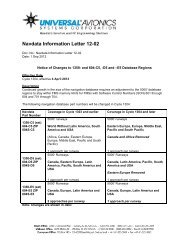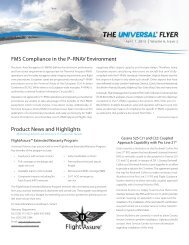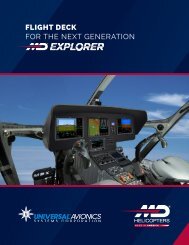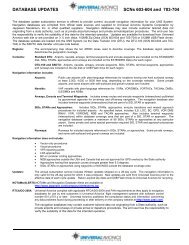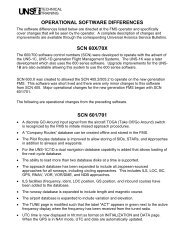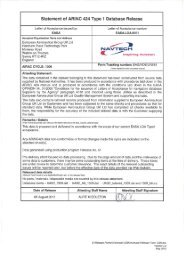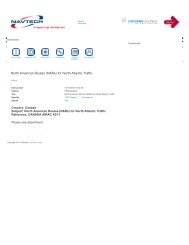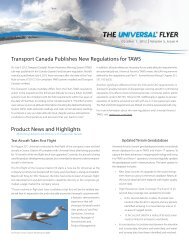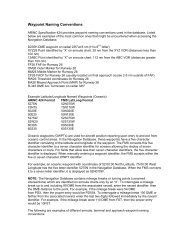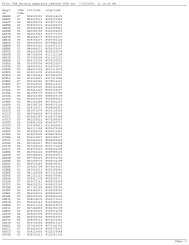THE FLYER - Universal Avionics
THE FLYER - Universal Avionics
THE FLYER - Universal Avionics
You also want an ePaper? Increase the reach of your titles
YUMPU automatically turns print PDFs into web optimized ePapers that Google loves.
<strong>THE</strong><br />
October 1, 2008<br />
<strong>FLYER</strong><br />
RAIM Prediction - More Important Than Ever<br />
Effective July 1, 2009, the Predictive RAIM requirement outlined in<br />
FAA Advisory Circular (AC) 90-100A will be enforced for all operators<br />
in U.S. airspace. According to the AC, RNAV operators must<br />
complete enroute and terminal RAIM Predictions when using GPS<br />
as the only means of RNAV 1 and RNAV 2 procedure compliance.<br />
A four-phase implementation schedule of the Predictive RAIM requirement<br />
was recently released by the FAA’s Performance-based<br />
Operations Aviation Rulemaking Committee (PARC).<br />
Chartered in 2004, the PARC was tasked to review a number of<br />
issues affecting the implementation of performance-based navigation<br />
procedures and criteria. Future notifications and guidelines are expected<br />
as the transition to performance-based navigation progresses.<br />
Volume 1, Issue 3<br />
Pilot’s Tool Kit<br />
<strong>Universal</strong> <strong>Avionics</strong> WAAS/SBAS-FMSs Our <strong>Universal</strong> Flight<br />
are TSO-C146b compliant, therefore Planning (UFP) program<br />
operators are not subject to the RAIM provides enroute and<br />
Prediction requirement when the<br />
terminal GPS RAIM<br />
route is contained within the WAAS Prediction. Download<br />
coverage area (RAIM Prediction is<br />
for free at www.uasc.com.<br />
required when outside the WAAS<br />
coverage area). Operators of older FMSs, which are certified to<br />
TSO-C115, must complete RAIM Predications as described in<br />
AC 90-100A. Refer to <strong>Universal</strong> <strong>Avionics</strong> Service Letter No. 2804:<br />
”UASC FMS Compliance with FAA Advisory Circular 90-100A” for<br />
compliance information specific to your FMS version.<br />
New Product News<br />
WAAS and Weather All-In-One Antenna<br />
Look for more new<br />
product announcements<br />
during the 61st Annual<br />
NBAA Meeting and Convention. Visit <strong>Universal</strong><br />
<strong>Avionics</strong> Booth #4359 for a product demonstration.<br />
<strong>Universal</strong> is pleased to announce the addition of a dual-element GPS/WAAS<br />
and WSI antenna to its product line. The new antenna is ideal for those who<br />
want WSI InFlight weather capabilities but have limited aircraft space or<br />
location for a stand-alone antenna. It has the same footprint as the current<br />
GPS/WAAS antenna. Look for antenna P/N 10709 later this year.<br />
Tucson Training Center<br />
Contact: Carol Jett<br />
<strong>Universal</strong> <strong>Avionics</strong> Systems Corp.<br />
3260 E. <strong>Universal</strong> Way<br />
Tucson, AZ 85756<br />
Tel: (520) 295-2383 or (800) 595-5906<br />
Fax: (520) 295-2384<br />
Email: cjett@uasc.com<br />
Wichita Training Center<br />
Contact: Katie Cornette<br />
<strong>Universal</strong> <strong>Avionics</strong> Systems Corp.<br />
3815 Midco St.<br />
Wichita, KS 67215<br />
Tel: (316) 524-9500 or (800) 255-0282<br />
Fax: (316) 524-9700<br />
Email: kcornette@uasc.com<br />
WAAS Training Is Here<br />
<strong>Universal</strong> <strong>Avionics</strong> Training Department is pleased to announce the addition<br />
of WAAS/SBAS-FMS operator and technician training classes to its schedule.<br />
Training classes are the most comprehensive way to learn how to operate<br />
and maintain your FMS. <strong>Universal</strong>’s “hands-on” approach allows you to fully<br />
explore the features of the FMS to best fit your needs.<br />
Courses are available in our Tucson, AZ or<br />
Wichita, KS locations; worldwide on-site training<br />
may also be arranged. Training is available for a<br />
wide range of <strong>Universal</strong> <strong>Avionics</strong> products.<br />
To schedule a course, contact the facility<br />
nearest you or call (800) 595-5906.<br />
Receive The <strong>Universal</strong> Flyer by mail or email. To update your mailing preferences, email universalflyer@uasc.com or call 1-800-321-5253.
Page 2<br />
Volume 1, Issue 3<br />
RNAV and RNP: Clearing the Air<br />
What is RNAV? RNP? Is my FMS compliant?<br />
Does it need to be?<br />
These are just a few of many questions we<br />
field everyday about RNAV and RNP. As<br />
two of the most complex subjects of GPSbased<br />
navigation, it can be extremely confusing<br />
to operators and installers alike.<br />
While we don't have room to go into detail<br />
about specific aircraft requirements, let’s<br />
address some of the basics behind RNAV<br />
and RNP.<br />
What is RNAV?<br />
Area Navigation (RNAV) is a method of<br />
navigation that allows an aircraft to fly any<br />
desired path or flight plan within the coverage<br />
of ground-based or satellite-based navigation<br />
aids. Traditional flight paths require<br />
aircraft to navigate directly to and<br />
from a specific ground-based navigation<br />
aid, but RNAV allows aircraft<br />
to navigate directly from a<br />
given departure to an arrival point.<br />
Am I RNAV Compliant?<br />
Current G round<br />
NAVAIDs<br />
to <strong>Universal</strong> <strong>Avionics</strong> Service Letter No.<br />
2804: ”UASC FMS Compliance with FAA<br />
Advisory Circular 90-100A” for compliance<br />
information specific to your FMS version.<br />
What is RNP?<br />
The term “RNP” is used in several different<br />
contexts. Required Navigation Performance<br />
(RNP) can refer to a type of RNAV operation<br />
requiring additional performance capabilities.<br />
Aircraft approved for RNP operations<br />
must have equipment that provides<br />
onboard navigation containment, performance<br />
monitoring and alerting capabilities.<br />
The term “RNP” may also refer to a certain<br />
navigational performance necessary for aircraft<br />
operating within a defined airspace; not<br />
necessarily equipped with containment<br />
Conventional<br />
Routes<br />
RNAV<br />
Routes<br />
Waypoints<br />
RNP<br />
Routes<br />
Narrow TERPS<br />
parameters or alerting functionality. For<br />
instance, RNP-10 and RNP-4 are oceanic<br />
airspace areas defined by the FAA that require<br />
specific operational approval. Two<br />
current European RNP airspace requirements<br />
are B-RNAV and P-RNAV, which are<br />
outlined in AC 90-96A.<br />
What is the RNP level of my FMS?<br />
An FMS alone cannot be certified for RNP<br />
operations. An aircraft is certified to a particular<br />
RNP level, which is based on the<br />
aircraft’s capabilities to meet performance<br />
level requirements.<br />
In order to receive FAA approval for RNP,<br />
an operator must meet both aircraft airworthiness<br />
requirements as well as operational<br />
requirements. Among the requirements,<br />
the operators must have a statement<br />
in their AFMS or approval<br />
from their Principal <strong>Avionics</strong> Inspector<br />
(PAI) establishing that the<br />
aircraft meets the equipment requirements.<br />
Seamless<br />
Vertical<br />
Path<br />
Aircraft must have a combination of<br />
TSO-C129 or C146 certified GPS<br />
sensors or TSO-C115 FMS, and a<br />
current navigation database. RNAV<br />
aircraft equipage requirements are<br />
outlined in FAA Advisory Circular<br />
(AC) 90-100A. Most <strong>Universal</strong><br />
FMSs are RNAV-compliant. Refer<br />
Current Ground<br />
NAVAIDs<br />
IncreasedAirspace<br />
Efficiency<br />
“curved”<br />
paths<br />
Optimized<br />
Use of Airspace<br />
<strong>Universal</strong> WAAS/SBAS-FMSs and<br />
Super FMSs (SCN 80X/90X and<br />
later) meet the performance monitoring<br />
and alerting requirements for<br />
RNP approval. Please contact Customer<br />
Support at 1-800-595-5906<br />
with any questions regarding FMS<br />
compliance for RNP operations.<br />
Software and Hardware Updates<br />
Terrain Database<br />
Terrain DB 0805 approved for<br />
TAWS P/N 3010-XX-XX and<br />
Vision-1 ® P/N 3015-00-00 on<br />
6/9/08.<br />
EFI-890R<br />
SCN 1017.1.2 approved<br />
6/11/08 for P/N 8904-35533-0X.<br />
This minor software change<br />
adds configuration support for<br />
several new aircraft types.<br />
SCN 1017.1.3 expected 4th<br />
quarter. This minor software<br />
change adds further configuration<br />
support for several new<br />
aircraft types.<br />
CCP<br />
Cursor Control Panel (CCP)<br />
SCN 12.0 approval expected 4th<br />
quarter. Minor Software change<br />
adds dual CCP capabilities in<br />
ASU/EFI-890R installations.<br />
GPS/WAAS Antenna<br />
GPS/WAAS and WSI Antenna,<br />
P/N 10709, expected 4th quarter.<br />
Provides WSI InFlight<br />
capabilities via the Sirius satellite<br />
network for WAAS/SBAS-FMS<br />
and ASU installations.<br />
UniLink 701<br />
SCN 22.X ETSO approved<br />
6/10/08.
Volume 1, Issue 3<br />
Page 3<br />
Introducing…<br />
The Technical Marketing Department<br />
Is there any “plug and play” to your cockpit? If there is, it probably won’t be that way for long.<br />
Integrated avionics, such as electrical instruments and all-in-one FMSs, have made the “plug and play”<br />
environment something of the past. Subsequently, seamless integration between various manufacturers’<br />
equipment is more important than ever, especially in retrofit installations.<br />
As a company dedicated to serving the retrofit market, <strong>Universal</strong> <strong>Avionics</strong> made a recent change to its<br />
organizational structure in order to facilitate resolution of complex integration challenges efficiently and<br />
effectively as possible. Without further ado, let us introduce our new Technical Marketing Department.<br />
“The emergence of digital cockpits<br />
and integrated avionics has made<br />
installations more complex; we saw<br />
the need for a dedicated team to<br />
support our products in the installation<br />
design and process. This assures the<br />
installation takes advantage of all the<br />
rich features of our equipment.”<br />
– Paul DeHerrera,<br />
Chief Operating Officer<br />
Comprised of talented engineers with exceptional skill and experience in integrating various avionics systems<br />
and led by a seasoned <strong>Universal</strong> manager, the Technical Marketing Department will support the upfront<br />
development of interfaces, review latest products and provide integration support for new installation platforms. While <strong>Universal</strong> has long<br />
utilized an extensive lab and engineering team for integration research, this group is fully dedicated to new integrations and is aligned within the<br />
marketing department to ensure technical details are discussed early in the sales process. In essence, mitigating risk during system integration.<br />
Leading the new team is 16-year <strong>Universal</strong> <strong>Avionics</strong> veteran, Grady Dees, as Director of Technical Marketing. Mr. Dees has held a number of<br />
positions at <strong>Universal</strong>, most recently as Director of Engineering Services. The group has extensive and varied experience in systems integration<br />
and STC project management of large corporate and heavy transport aircraft, as well as with OEMs. Combined, the team has over 50 years<br />
experience at <strong>Universal</strong> <strong>Avionics</strong> alone.<br />
The Technical Marketing group has streamlined the investigative research<br />
and installation design process by developing a standardized<br />
data collection method and a centralized knowledge base. The UASC<br />
Equipment Survey spreadsheet, for instance, is a valuable tool for gathering<br />
information about the existing aircraft installation. Based on the<br />
equipment survey, the group provides feedback to the dealer on issues<br />
with compatibility and suggested solutions. With a completed equipment<br />
survey, a proposed port allocation spreadsheet can be provided<br />
that identifies a suggested basic integration design.<br />
Grady Dees (sitting) with Scott Sides, Jason Mason and Ernie Lear in the Integration Lab<br />
The key to an effective and efficient (ultimately successful) installation<br />
is to start communication as early as possible in the design process.<br />
By taking a proactive approach, we can field issues that can be<br />
anticipated and respond more effectively to those that are unexpected.<br />
Service Bulletins and Letters<br />
SB/SL No. Release Date Title<br />
SL2815 6/3/08 Installation Considerations for <strong>Universal</strong>'s WAAS FMS<br />
SL2814 6/6/08 Compliance Summary for RNP-4 Operations<br />
SB3220 7/16/08 Introduction of SCN 11.4 for Class A and B TAWS<br />
SB3293 7/24/08 Announcement of the Availability of TAWS Terrain Database 0805<br />
SB3296 8/18/08 Installation of SCN 1017.1.2 in EFI-890R PFD and ND System<br />
SB3292 8/21/08 Introduction of the LP/LPV Monitor P/N 3116-52-1110<br />
SB3297 ALERT 8/27/08 WAAS FMS SCN 1000.X/1100.X Flight Plan Crossfill Operations<br />
This Just In...<br />
Technical Publications released a new<br />
EFI-890R Flat Panel Display Operator’s<br />
Manual, Report No. 34-20-08.02. This<br />
manual is effective for SCN 1017.1.X<br />
only. Additions to the manual include a<br />
description of the video capabilities that<br />
was added in SCN 1017.1.X .<br />
The current EFI-890R Operator’s Manual,<br />
Report No. 34-20-08.01, will be<br />
revised to reflect applicability for all<br />
software versions prior to SCN 1017.1.X.
Why You Should Upgrade Your <strong>Avionics</strong> in 2008<br />
Volume 1, Issue 3<br />
On the fence about cockpit upgrades? If your<br />
business is based in the U.S., it may be worthwhile to<br />
check with your tax advisor about limited-time tax<br />
incentives that could provide substantial cost savings.<br />
The Economic Stimulus Act of 2008 - legislation that<br />
provided the stimulus checks for individuals earlier<br />
this year - also contains tax incentives for businesses.<br />
The act includes provisions that allow accelerated<br />
depreciation for aircraft purchases and expands the<br />
Section 179 Expensing code.<br />
The Section 179 Expensing code allows businesses<br />
to treat certain purchases as expenses, which can<br />
therefore be deducted in the first year of service.<br />
Operating expenses for business-use aircraft,<br />
including capital improvements to aircraft avionics,<br />
interior or engines, meet this provision.<br />
The Economic Stimulus Act expanded Section<br />
179 by increasing the total amount of expenses<br />
the business can deduct from $128,000 to<br />
$250,000. This applies to modifications,<br />
refurbishments, improvements, and additions<br />
and replacements of avionics equipment.<br />
For capital purposes exceeding $250,000,<br />
businesses can first take advantage of the<br />
Section 179 incentive, then apply “Bonus<br />
Deprecation” for the remainder of the cost.<br />
Reminiscent of “Hurry! Limited Time Offer”<br />
taglines, the Economic Stimulus Act applies<br />
only to purchases placed into service in 2008.<br />
Businesses could garner substantial savings by<br />
completing upgrades in the next few months<br />
rather than putting them off until next year.*<br />
Inside this issue:<br />
RAIM Prediction -<br />
More Important Than<br />
Ever<br />
1<br />
New Product News 1<br />
RNAV and RNP:<br />
Clearing the Air<br />
Software and<br />
Hardware Updates<br />
Introducing...The<br />
Technical Marketing<br />
Department<br />
Service Bulletins<br />
and Letters<br />
2<br />
2<br />
3<br />
3<br />
*Please discuss your specific situation with your tax or legal advisor so that you can plan your strategy properly.<br />
© 2008 <strong>Universal</strong> <strong>Avionics</strong> Systems Corporation. All rights reserved. The <strong>Universal</strong> Flyer is intended for general information purposes only. <strong>Universal</strong> does not assume or accept<br />
responsibility for any use of such information. <strong>Universal</strong> technical manuals and operator’s manuals take precedence over the content of this publication.<br />
3260 E. <strong>Universal</strong> Way<br />
Tucson, AZ 85756<br />
Corporate Offices<br />
Marketing/Support<br />
3260 E. <strong>Universal</strong> Way<br />
Tucson, AZ 85756 U.S.A.<br />
Tel: (520) 295-2300<br />
(800) 321-5253<br />
Fax: (520) 295-2395<br />
Internet<br />
www.uasc.com<br />
E-mail: info@uasc.com



